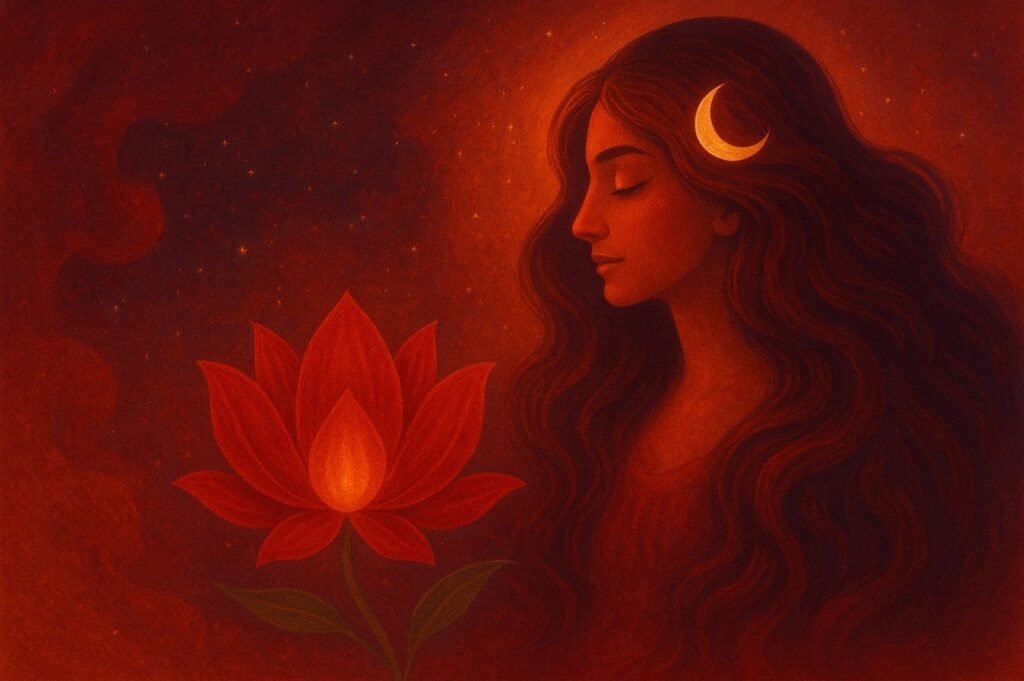“युवतीनाम् मासे मासे पुष्पवत् आर्तवम् भवति।” (Sushruta Samhita)
In young women, each month the Artava (menstruation) blossoms like a flower.
In Ayurveda’s eyes, a woman is a living symphony. She is a whole universe of body, mind, and spirit, with her cycles simply reflecting the harmony within. The monthly rhythm of menstruation is known as Artava or Pushpa darshanam in ancient texts. That’s why when something like PCOS or PCOD happens, Ayurveda doesn’t just see “hormonal imbalance.” It sees a whole ecosystem out of sync – digestion, emotions, energy, sleep, metabolism, and the subtle channels that carry life-force.
When most doctors talk about PCOS, the conversation starts and ends with hormones; estrogen, progesterone, androgens, insulin. But Ayurveda takes one look at that limited view and says, “Dear woman, you’re not just a bundle of lab reports – you’re more than that.”
And here’s the beauty; when you heal the whole, the hormones often follow.
Understanding Artava Dushti: When the Rhythm Falters
Every month, the body prepares for a possible new life, and even when conception doesn’t happen, the cycle completes itself in a graceful release.
The human body is governed by three fundamental energies – Vata, Pitta, and Kapha; collectively known as the Tridoshas. These doshas work through 7 structural and functional components called Dhatus (tissues), each nourishing and supporting the next in a sequential chain.
Among the seven, Rasa Dhatu (the nutrient plasma formed soon after digestion) plays a special role in women’s health. It has two Upadhatus (secondary tissues) i.e. Stanya & Artava, Artava is the menstrual blood and ovulatory essence that is vital for reproduction.

Signs of Healthy Menstrual Blood
“गुञ्जाफल सवर्ण च पध्म आलक्तक सन्निभम्।
इन्द्रगोपक सड़काशम् आर्तव शुद्धम् आदिशेत्॥” (Charaka Samhita)
⭐ Varna: Color like the red of a gunja fruit or red lotus (bright, fresh, uniform).
⭐ Gandha: Mild, natural fragrance – not unpleasant.
⭐ Sparsha: Smooth, unctuous texture.
⭐ Avikala: Pure, without deformity or irregularity.
⭐ Pinda rahita: Free from clots or thick lumps.
⭐ Pramana: Neither too much nor too little flow.
⭐ Pravriti: Flows naturally and without pain or burning.
These qualities reflect a balanced interplay of doshas, strong digestive fire (agni), unobstructed reproductive channels (artavavaha srotas), and stable mental health.
When Artava Deviates from the Ideal
If Artava does not align with these classical features, ayurveda considers it artava dushti – a vitiation or abnormality of menstrual function. This imbalance can present as:
- Kashtartava (Dysmenorrhoea): painful menstruation.
- Asrigdara (Menorrhagia): heavy or prolonged bleeding.
- Anartava (Amenorrhoea): absence of menstruation.
- Nashtartava: Irregular cycles or spotting.
Over time, chronic Artava Dushti can also contribute to uterine and ovarian disorders such as; Endometriosis, Adenomyosis, Uterine fibroids, Ovarian cysts (including PCOD patterns).
What actually happens at dosha level
“ग्रन्थिभूतं श्लेष्मवाताभ्याम् l” (Sushruta Samhita)
Cyst-like growths in Artava are caused by vitiated Kapha and Vata.
One of the eight main types of Artava Dushti is Granthi Bhuta Artava Dushti – where the menstrual blood and ovulatory essence develop Granthis (cysts or lumps). Let’s understand what happens dosha wise:
- Kapha: Slow, sticky, and cool. It’s what makes you feel heavy, tired, and bloated. It’s also the dosha behind cysts and weight gain.
- Vata: Dry, erratic, airy. Irregular cycles, anxiety, insomnia, and gas-that-could-power-a-small-car? That’s Vata talking.
- Ama: Undigested waste that clogs the system.
🌿 What Ayurveda Actually Suggests (And No, It’s Not Just Turmeric Everything)
The main goal of healing is to first remove the toxins that interfere with nourishment. After cleansing our body, our cells start breathing and then healing starts. Here are the steps:
- Activate Agni: Digestive fire.
- Shodhana & Shamana: Remove Ama (toxins), Artava shuddhi.
- Rasayan: Strengthen reproductive vitality.
Now let’s understand each of them in detail;
Activate Agni
“हिताहितं सुखं दुःखमायुस्तस्य हिताहितम् ।
मानं च तच्च यत्रोक्तमाहारः स तु पञ्चधा ॥”(Charaka Samhita)
- Include: Warm, light, freshly cooked meals, spices like ginger, cumin, turmeric.
- Avoid: Cold, heavy, oily foods, excess dairy, refined sugar.
In Ayurveda, your digestion is queen (Agni). If it’s weak, nothing else will thrive. So, choose wisely:
- Warm foods over cold or raw salads.
- Use gentle, metabolism-friendly spices (cumin, ginger, fenugreek).
- No more skipping meals or snacking like a Netflix zombie.
Your gut is not a garbage disposal. Respect it, and it will pay you back in energy, regular cycles, and maybe even a post-lunch glow.
Shodhana & Shamana (Cleansing & Pacifying)
“वमनानि विरेचनानि बस्तयश्चोपशान्तये॥” (Charaka Samhita)
In disorders caused by Vata – Kapha, therapies like Vamana (Emesis), Virechana (Purgation), and Basti (cleanses the uterine & ovarian channels & nourishes the body & mind) are beneficial for pacification; but strictly under Vaidya supervision only.
Rasayan (Rejuvenation)
“यत्तद् जीर्णवयस्यां धातूनां परिपूरणमनुपहतानां च धातूनामुपचयकरं बलकरं च तत् रसायनम्।” (Charaka Samhita)
Rasayana is that which replenishes the tissues, nourishes unimpaired tissues, promotes growth, and imparts strength. There are herbs & formulations that are amrita (nectar) to the uterus and to women, like; Shatavari, Shatpushpa, Lodhra, Phalaghrita.
Lifestyle is the New Medicine
“दिनचर्या नृणां धर्म्या रक्षत्यारोग्यमादृताः।” (Ashtanga Hridaya)
Daily routine, when followed, protects health and preserves vitality.
“प्राणायामोऽनिलोद्धारस्तेन चित्तं प्रशाम्यति।” (Hatha Yoga Pradipika)
Pranayama controls the flow of Vata and brings mental peace.
- Waking up before sunrise reduces kapha heaviness.
- Self-massage with warm oils (abhyanga) is like telling your nervous system, “Hey, I got you.”
- Yoga asana – Baddha Konasana, Malasana, Setu Bandhasan.
- Seasonal cleansing – light fasting in kapha season.
- Anuloma Viloma, Bhramari – calms the mind and reduces stress hormones.
🧠 Stop Stressing or Start Journaling About It
Ayurveda insists on one truth – your mind affects your ovaries. Chronic stress tells your body, “We’re in survival mode, no time to ovulate.” You can add simple things in your lifestyle like: meditation, deep breaths, screaming into a pillow, writing sad poems, laughing at memes.
Research Spotlight
Modern studies on Ayurveda for PCOS show promising results. Case reports document restored cycles, improved ovarian health, healthy weight loss, and even successful pregnancies (PubMed, PMC Case Study, Ayu Journal). While most research is small-scale, it highlights Ayurveda’s holistic potential in managing PCOS.
- A scoping review that analyzed 57 clinical studies – including randomized trials, case reports, and Panchakarma based interventions found promising results. Single herbs and compound formulas were frequently used. Notably, Basti (medicated enema) emerged as the most common complex intervention. Most studies reported positive outcomes in menstruation regulation, fertility improvement, and resolving polycystic ovarian morphology.
- In a pragmatic clinical study involving 40 subfertile women with PCOS (correlated with ayurveda’s artava kshaya), a structured 6 months Ayurvedic protocol involving Shodhana, Shamana, and Tarpana therapies showed significant improvement in hormonal balance, reduction in ovarian cysts, and restored fertility.
PCOD vs PCOS — Knowing the Difference
In PCOD, the ovaries produce many immature eggs that often turn into small cysts. This is usually linked to lifestyle factors like poor diet, stress, or lack of physical activity. It’s quite common, generally milder, and many women can restore balance with simple lifestyle changes.
PCOS, on the other hand, is a deeper hormonal and metabolic disorder. The body produces higher than normal male hormones (androgens), leading to irregular ovulation, cyst formation, weight gain, skin issues, and sometimes infertility. It’s often connected to insulin resistance and can increase the risk of diabetes, heart problems, and other long-term health issues.
Yes, your hormones are involved, but they’re not the villains. They’re the messengers. Think of them as tiny, exhausted interns running around your body trying to meet impossible deadlines. When they start screaming, it’s because something deeper is off.
Modern medicine zooms in on your lab results.
Ayurveda steps back and asks: What’s your digestion like? How’s your sleep? Are you breathing deeply?
It’s not woo woo – it’s whole-you.
👩⚕️ Conversations in every PCOS Appointment Ever
Doctor: “Just lose some weight.”
You: “Cool. Should I grow a second pancreas while I’m at it?”
Doctor: “Your periods will regulate once you’re on the pill.”
You: “So the solution to irregular periods… is fake ones?”
Doctor: “…yes.”
In that moment, you leave your body; not out of drama, but out of exhaustion.
Because you realize you’re not being treated like a whole person, just a list of symptoms.
This is why so many women are turning to Ayurveda for PCOS, not because it’s trendy or celebrity endorsed but because it treats you like a person, not a chart.
From Granthi to Garbha – Restoring the Flowering Within
PCOS is not just about “hormones gone wrong.”
In Ayurveda, it is seen as Granthi Bhuta Artava Dushti – an imbalance in Kapha and Vata that creates blockages in the delicate reproductive channels. By purifying, nourishing, and aligning with nature’s rhythms, a woman can restore her innate Shakti.
🌿 Start Today: 3 Easy Shifts
Before you even finish reading this blog… pause.
Close your eyes. Inhale deeply through your nose for a count of 4, exhale slowly for a count of 6.
Do it 3 times; feel your shoulders drop, your jaw unclench.
You’ve just started healing.
- Warm Start: Begin your morning with a glass of water to wake up your digestion.
- Move & Stretch: 20 minutes of gentle yoga or walking to boost pelvic circulation.
- Eat Fresh & Warm: Prioritise freshly cooked, spiced meals over cold or packaged foods.
Healing begins in the smallest, most mindful moments – like the one you just had.
If you experience irregular cycles, unexplained weight changes, or other PCOS symptoms – listen to your body. Ayurveda offers time-tested, gentle, and powerful ways to heal at the root.
📞 Consult a qualified Vaidya for a personalized plan that blends Aushadhi chikitsa, Panchakarma, Dincharya and Rasayana therapies tailored according to your Prakriti & Vikriti.
If you love this blog, there’s so much more ancient wisdom waiting for you. Dive into my other blogs to explore Ayurvedic lifestyle tips, deeper healing practices and practical recipes for health; so, you can feel truly at home in your body again.
Vaidya Kanchan
LinkedIn: https://www.linkedin.com/in/vaidya-kanchan/

